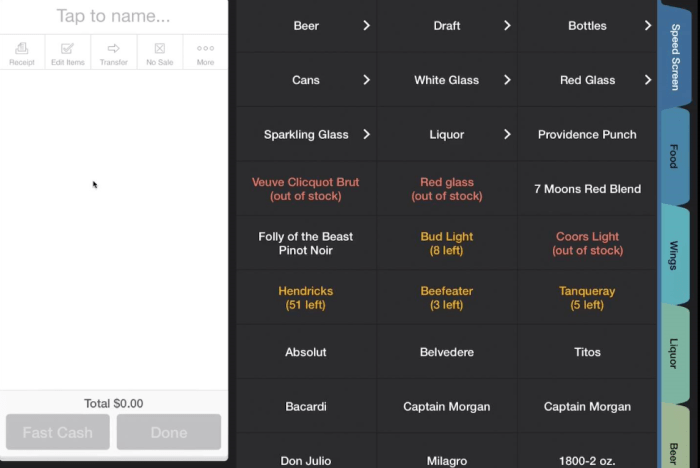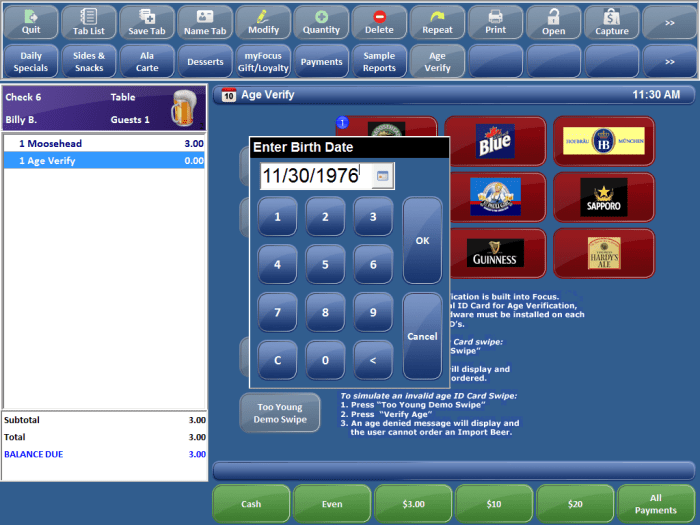Bar POS system software is revolutionizing the hospitality industry, offering a streamlined approach to managing daily operations. From order taking and inventory management to employee scheduling and sales reporting, a robust POS system can significantly improve efficiency and profitability. These systems often integrate seamlessly with other business tools, providing a holistic view of your bar’s performance and facilitating data-driven decision-making.

Source: fitsmallbusiness.com
The right system can even enhance the customer experience through faster service and personalized interactions.
Features such as touch screen interfaces, integrated payment processing, and robust reporting capabilities are becoming increasingly standard. Choosing the right system depends on factors such as bar size, menu complexity, and specific business needs. Consider scalability, ease of use, and customer support when making your selection, as these factors will greatly influence your long-term success.
In today’s competitive retail landscape, efficiency and accuracy are paramount. Point of Sale (POS) system software has evolved from a simple cash register to a powerful, multifaceted tool that manages every aspect of a business, from sales transactions to inventory management and customer relationship management (CRM). This comprehensive guide explores the intricacies of POS system software, its key features, benefits, and considerations for choosing the right system for your business.
Understanding the Core Functionality of POS System Software
At its heart, POS software streamlines the sales process. It replaces traditional cash registers, offering a digital interface for processing transactions quickly and accurately. But its capabilities extend far beyond simple sales recording. A robust POS system integrates several crucial functionalities:
Transaction Processing: The Foundation of POS
- Sales Recording: Accurate and detailed recording of each sale, including item details, quantity, price, discounts, and payment methods (cash, credit/debit cards, mobile payments like Apple Pay and Google Pay, gift cards).
- Inventory Management: Real-time tracking of inventory levels, helping businesses avoid stockouts and overstocking. This often includes features for managing low stock alerts, automated reordering, and detailed inventory reports.
- Payment Processing: Seamless integration with various payment gateways to facilitate secure and efficient transactions. This includes support for EMV chip cards, contactless payments, and online payment options.
- Receipt Generation: Automated generation of itemized receipts, including sales tax calculations and other relevant information. Many systems offer customizable receipt templates for branding purposes.
Beyond Transactions: Advanced POS System Features
Modern POS systems offer a wealth of advanced features that enhance operational efficiency and provide valuable business insights:
Customer Relationship Management (CRM)
- Customer Database: Centralized storage of customer information, including purchase history, preferences, and contact details, enabling targeted marketing and personalized customer service.
- Loyalty Programs: Integration with loyalty programs to reward repeat customers and encourage brand loyalty. This often involves points accumulation, discounts, and exclusive offers.
- Customer Analytics: Gathering data on customer behavior to identify trends, preferences, and areas for improvement in products or services.
Reporting and Analytics: Data-Driven Decision Making
- Sales Reports: Detailed reports on sales performance, including revenue, average transaction value, best-selling items, and sales trends over time.
- Inventory Reports: Tracking inventory levels, identifying slow-moving items, and optimizing stock management.
- Employee Performance Reports: Monitoring employee sales, transaction speed, and error rates to assess performance and identify areas for training.
- Profitability Analysis: Calculating gross profit margins, identifying profitable products, and understanding overall business profitability.
Employee Management: Streamlining Operations
- Employee Scheduling: Creating and managing employee schedules, optimizing staffing levels to meet business needs.
- Access Control: Assigning different permission levels to employees based on their roles and responsibilities.
- Time and Attendance Tracking: Accurately tracking employee work hours for payroll purposes.
Integration with Other Business Systems, Bar pos system software
Many POS systems offer seamless integration with other business software, such as accounting software (QuickBooks, Xero), e-commerce platforms (Shopify, WooCommerce), and CRM systems (Salesforce, HubSpot). This integration eliminates data silos and improves overall business efficiency.
Choosing the Right POS System: Key Considerations
Selecting the right POS system is a crucial decision. Consider these factors:
- Business Size and Needs: A small business may require a simpler system than a large retail chain with multiple locations.
- Budget: POS systems range in price from basic, affordable options to sophisticated, enterprise-level solutions.
- Hardware Compatibility: Ensure compatibility with your existing hardware, or plan for necessary upgrades.
- Software Features: Identify the essential features for your business and choose a system that meets those needs.
- Scalability: Select a system that can grow with your business, accommodating future expansion and increased transaction volume.
- Customer Support: Reliable customer support is essential for resolving technical issues and receiving assistance when needed.
- Security: Prioritize systems with robust security measures to protect sensitive customer and business data.
Types of POS Systems
POS systems are available in various forms, each with its own advantages and disadvantages:

Source: focuspos.com
- Cloud-Based POS: Software hosted on a remote server, accessible from anywhere with an internet connection. Offers flexibility and scalability.
- On-Premise POS: Software installed on a local server within the business. Offers greater control but requires more IT maintenance.
- Mobile POS (mPOS): Software designed for mobile devices like tablets and smartphones. Ideal for businesses with mobile sales operations or pop-up shops.
Frequently Asked Questions (FAQ)
- Q: How much does POS software cost? A: The cost varies greatly depending on the features, scalability, and vendor. Expect to pay anywhere from a few hundred dollars per year for basic cloud-based systems to thousands of dollars for enterprise-level solutions.
- Q: What are the benefits of using a POS system? A: Benefits include increased efficiency, improved accuracy, better inventory management, enhanced customer relationships, and valuable business insights.
- Q: Is POS software difficult to use? A: Most modern POS systems are designed with user-friendliness in mind. However, the complexity can vary depending on the system’s features and functionality. Training is often provided by vendors.
- Q: Can I integrate my POS system with other software? A: Many POS systems offer integration capabilities with accounting software, e-commerce platforms, and CRM systems. Check the system’s specifications to ensure compatibility.
- Q: What security measures should I look for in a POS system? A: Look for systems with encryption, secure payment gateways, access controls, and regular software updates to protect against security breaches.
Conclusion
POS system software is an indispensable tool for modern businesses. By streamlining operations, providing valuable insights, and enhancing customer relationships, a well-chosen POS system can significantly contribute to a business’s success. Carefully consider your business needs, budget, and long-term goals when selecting a system to ensure a seamless integration and optimal performance.
References
While specific product links are avoided to maintain neutrality, research reputable software review sites and the websites of major POS providers for detailed information on specific products and their features. Look for reviews and comparisons to aid your decision-making process.
Call to Action: Bar Pos System Software
Ready to upgrade your business with a powerful POS system? Contact us today for a free consultation to determine the best solution for your unique needs!
Ultimately, investing in the right bar POS system software is a strategic move that can transform your business. By streamlining operations, enhancing customer service, and providing valuable data insights, these systems empower bar owners to focus on what truly matters: creating a thriving and profitable establishment. The benefits extend beyond simple transaction processing; they encompass a comprehensive solution for managing all aspects of your bar’s daily operations, contributing to a more efficient, profitable, and enjoyable work environment.
Clarifying Questions
What are the typical costs associated with bar POS system software?
Costs vary widely depending on features, vendor, and contract length. Expect to pay a one-time purchase price, monthly subscription fees, or a combination of both. Additional costs may include hardware, installation, and training.
How do I choose the right POS system for my specific bar?
Consider your bar’s size, menu complexity, payment processing needs, and integration requirements. Research different vendors, compare features and pricing, and read reviews before making a decision. A free trial or demo can be invaluable.

Source: ecashcloud.com
What kind of training is typically offered with bar POS system software?
Most vendors offer some form of training, either online, in-person, or both. The level of training varies, so check what’s included before purchasing. Effective training ensures your staff can use the system efficiently and accurately.
What security measures are in place to protect sensitive data?
Reputable POS system providers prioritize data security. Look for systems with encryption, secure payment gateways, and regular security updates. Ask about their security protocols and compliance certifications.
